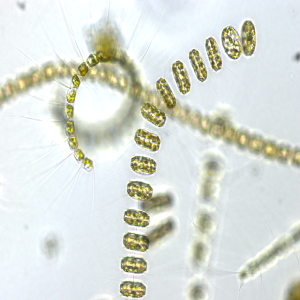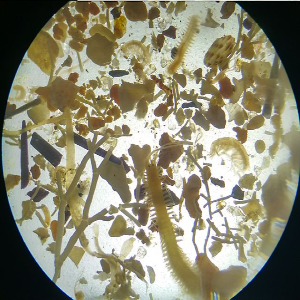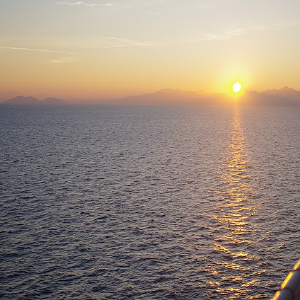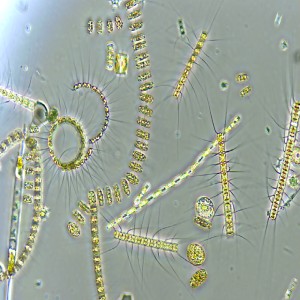Geographical, environmental, and biotic constraints define the spatial distribution of Diaphanosoma species (Cladocera)
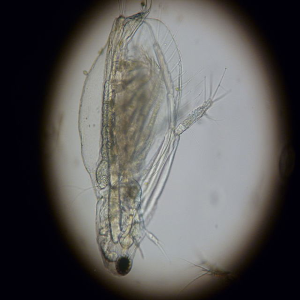
Accepted: 19 January 2023
SUPPLEMENTARY PDF: 22
HTML: 24
All claims expressed in this article are solely those of the authors and do not necessarily represent those of their affiliated organizations, or those of the publisher, the editors and the reviewers. Any product that may be evaluated in this article or claim that may be made by its manufacturer is not guaranteed or endorsed by the publisher.
Species distribution is a combination of ecological, historical, stochastic, and evolutionary mechanisms, and is a process that has been severely impacted by anthropogenic activities. Freshwater zooplankton is adequate to assess that combination because it groups cosmopolitan and endemic species. We hypothesized that the spatial distribution of Diaphanosoma species is defined by a complex interaction between factors such as spatial limitation, limitation of environmental conditions, and ecological conditions. We georeferenced the occurrence of Diaphanosoma in Brazil to study the potential distribution of the species, preference of ecoregions, environmental features associated with Diaphanosoma, and their co-occurring patterns. Five species of Diaphanosoma are widely distributed in Brazil. D. spinulosum and D. birgei were widely distributed while D. fluviatile and D. polyspina had a more restricted distribution. The occurrences of Diaphanosoma species were shown to have an association with factors such as the total concentrations of nitrogen and phosphorus, pH and, temperature, except in the case of the D. brevireme. Our results show that geographic, environmental, and biotic filters can drive the spatial distribution of species of the genus Diaphanosoma. Therefore, the distribution and spatial occurrence of these species depend on dispersal capacity and spatial restrictions, suitability of the abiotic environment, and ecological interactions.
Adamowicz SJ, Petrusek A, Colbourne JK, et al., 2009. The scale of divergence: A phy-logenetic appraisal of intercontinental allopatric speciation in a passively dispersed freshwater zooplankton genus. Molecular Phylogenetics and Evolution. 50:423–36. DOI: https://doi.org/10.1016/j.ympev.2008.11.026
Albert JS, Reis RE, 2001. Introduction to Neotropical Freshwaters. In: Historical Bioge-ography of Neotropical Freshwater Fishes (Eds: J. S. Albert, & R. E. Reis). Los An-geles, Univeristy of California Press.
Baas-Becking LGM, 1934. Geobiologie of inleiding tot de milieukunde. The Hague, Neth., W. P. Van Stockum & Zoon.
Best J, 2019. Anthropogenic stresses on the world’s big rivers. Nature Geoscience. 12:7–21. DOI: https://doi.org/10.1038/s41561-018-0262-x
Booth TH, Nix HA, Busby JR, Hutchinson MF, 2014. BIOCLIM: the first species dis-tribution modelling package, its early applications and relevance to most current MA-XENT studies. Diversity and Distributions. 20:1-9. DOI: https://doi.org/10.1111/ddi.12144
Brambilla MF, Casale F, Bergero V, et al., 2009. GIS-models work well, but are not enough: Habitat preferences of Lanius collurio at multiple levels and conservation im-plications. Biological Conservation. 142:2033–42. DOI: https://doi.org/10.1016/j.biocon.2009.03.033
Brendelberger H, 1991. Filter mesh size of cladocerans predicts retention efficiency for bacteria. Limnology and Oceanography. 36:884–94. DOI: https://doi.org/10.4319/lo.1991.36.5.0884
Cohen GM, Shurin JB, 2003. Scale-dependence and mechanisms of dispersal in freshwa-ter zooplankton. Oikos. 103: 603–17. DOI: https://doi.org/10.1034/j.1600-0706.2003.12660.x
De Meester L, Gómez A, Okamura B, Schwenk K, 2002. The Monopolization Hypothe-sis and the dispersal-gene flow paradox in aquatic organisms. Acta Oecologica. 23:121–35. DOI: https://doi.org/10.1016/S1146-609X(02)01145-1
Dirzo R, Young HS, Galetti M, et al., 2014. Defaunation in the Anthropocene. Science. 345:401–6. DOI: https://doi.org/10.1126/science.1251817
Dou P, Dong Y, Chen L, Yang HQ, 2022. Modeling the potential distribution of different types of Dendrocalamus sinicus, the strongest woody bamboo in the world, with Ma-xEnt model. PeerJ. 10:e13847. DOI: https://doi.org/10.7717/peerj.13847
Dumont HJ, Han BP, Guo FF, et al., 2021. Toward a phylogeny and biogeography of Diaphanosoma (Crustacea: Cladocera). Aquatic Ecology. 55:1207-22. DOI: https://doi.org/10.1007/s10452-020-09819-0
Ellis EC, 2019. Evolution: Biodiversity in the Anthropocene. Current Biology. 29: R831–3. DOI: https://doi.org/10.1016/j.cub.2019.07.073
Elmoor-Loureiro LMA, 1997. Manual de identificação de cladóceros límnicos do Brasil, Vol. 1. Brasília: Universa.
Finlay BJ, 2002. Global dispersal of free-living microbial eukaryote species. Science. 296:1061–3. DOI: https://doi.org/10.1126/science.1070710
Fletcher RJ, Didham RK, Banks-Leite C, et al., 2018. Is habitat fragmentation good for biodiversity? Biological Conservation. 226:9–15. DOI: https://doi.org/10.1016/j.biocon.2018.07.022
Franklin J, 2010. Mapping Species Distributions: Spatial Inference and Prediction. Cam-bridge University Press. DOI: https://doi.org/10.1017/CBO9780511810602
Fuentes-Reines JM, De Roa E Z, Morón E, et al., 2012. Conocimiento de la fauna de cla-docera (Crustacea: Branchiopoda) de la ciénaga grande de Santa Marta, Colombia. Boletin de Investigaciones Marinas y Costeras. 41:121–64.
Gotelli NJ, Rohde K, 2002. Co-occurrence of ectoparasites of marine fishes: A null model analysis. Ecology Letters. 5:86–94. DOI: https://doi.org/10.1046/j.1461-0248.2002.00288.x
Gräler B, Pebesma E, Heuvelink G, 2016. Spatio-temporal interpolation using gstat. R Journal. 8:204–18. DOI: https://doi.org/10.32614/RJ-2016-014
Griffith DM, Veech JA., Marsh CJ, 2016. cooccur: Probabilistic Species Co-Occurrence Analysis in R. Journal of Statistical Software. 69:1-17. DOI: https://doi.org/10.18637/jss.v069.c02
Han BP, Yin J, Lin X., Dumont HJ, 2011. Why is Diaphanosoma (Crustacea: Ctenopo-da) so common in the tropics? Influence of temperature and food on the population parameters of Diaphanosoma dubium, and a hypothesis on the nature of tropical cla-docerans. Hydrobiologia. 668:109–15. DOI: https://doi.org/10.1007/s10750-010-0501-7
Hastie TJ, Tibshirani RJ, 1990. Generalized additive models, 1ª ed. New York: Chapman & Hall. DOI: https://doi.org/10.1214/ss/1177013604
Heino J, Melo AS, Bini LM, 2015. Reconceptualising the beta diversity-environmental heterogeneity relationship in running water systems. Freshwater Biology. 60:223-35. DOI: https://doi.org/10.1111/fwb.12502
Hubbel S, 2001. The Unified Neutral Theory of Biodiversity and Biogeography. Prince-ton, Princeton University Press.
Korovchinsky N, 1992. Sididae and Holopediidae. Chapter 3. In: Guides to the identifica-tion of the micro invertebrates of the continental water of the world.to the Identifica-tion of the Microinvertebrates of the Continental Waters of the World. SPB Academic Publishers.
Korovchinsky NM, 2006. The Cladocera (Crustacea: Branchiopoda) as a relict group. Zoological Journal of the Linnean Society. 147:109–24. DOI: https://doi.org/10.1111/j.1096-3642.2006.00217.x
Korovchinsky NM, 2016. A new species of Diaphanosoma fischer, 1850 (Crustacea: Branchiopoda: Sididae) inhabits lakes of the western United States of America. Jour-nal of Limnology. 75:52–61. DOI: https://doi.org/10.4081/jlimnol.2015.1258
Krebs CJ, 2009. Ecology: The experimental analysis of distribution and abundance, 6ª ed. Vancouver, University of British Columbia.
Lansac‐Tôha FM, Bini LM, Heino J, et al., 2020. Scale‐dependent patterns of meta-community structuring in aquatic organisms across floodplain systems. Journal of Bi-ogeography. 48:872-85. DOI: https://doi.org/10.1111/jbi.14044
Liu P, Xu SL, Liao J, et al., 2021. Development of microsatellite markers for Diaphano-soma dubium (Crustacea, Cladocera) and application to seasonal population dynamics. Aquatic Ecology. 55:1189-206. DOI: https://doi.org/10.1007/s10452-020-09812-7
Martiny JBH, Bohannan BJ, Brown JH, et al., 2006. Microbial biogeography: putting microorganisms on the map. Nature Reviews Microbiology. 4:102–12. DOI: https://doi.org/10.1038/nrmicro1341
Matveev V, Gabriel W, 1994. Competitive exclusion in Cladocera through elevated mor-tality of adults. Journal of Plankton Research. 16:1083–94. DOI: https://doi.org/10.1093/plankt/16.9.1083
Menezes RF, Attayde JL, Kosten S, et al., 2019. Differences in food webs and trophic states of Brazilian tropical humid and semi-arid shallow lakes: implications of climate change. Hydrobiologia. 829:95–111. DOI: https://doi.org/10.1007/s10750-018-3626-8
Nix, HÁ, 1986. A biogeographic analysis of Australian elapid snakes. Atlas of elapid snakes of Australia. 7:4-15.
Nobre RLG, Caliman A, Cabral CR, et al.,2020. Precipitation, landscape properties and land use interactively affect water quality of tropical freshwaters. Science of the Total Environment. 716:137044. DOI: https://doi.org/10.1016/j.scitotenv.2020.137044
Pearson, R. G., Raxworthy, C. J., Nakamura, M., A. Townsend Peterson. 2007. Predict-ing species distributions from small numbers of occurrence records: A test case using cryptic geckos in Madagascar. Journal of Biogeography. 34:102–17. DOI: https://doi.org/10.1111/j.1365-2699.2006.01594.x
Perbiche-Neves G, Saito VS, Simões NR, et al., 2019. Distinct responses of Copepoda and Cladocera diversity to climatic, environmental, and geographic filters in the La Plata River basin. Hydrobiologia. 826:113–27. DOI: https://doi.org/10.1007/s10750-018-3722-9
Pither J, 2007. Comment on “Dispersal limitations matter for microbial morphospecies”. Science. 316:1124. DOI: https://doi.org/10.1126/science.1137525
Poff NLR, 1997. Landscape filters and species traits: Towards mechanistic understanding and prediction in stream ecology. Journal of the North American Benthological Socie-ty. 16:391–409. DOI: https://doi.org/10.2307/1468026
Rahel FJ, 2002. Homogenization of Freshwater Faunas. Annual Review of Ecology and Systematics. 33:291–315. DOI: https://doi.org/10.1146/annurev.ecolsys.33.010802.150429
Sarma SSS, Nandini S, Gulati RD, 2005. Life history strategies of cladocerans: compari-sons of tropical and temperate taxa. Hydrobiologia. 542:315–33. DOI: https://doi.org/10.1007/s10750-004-3247-2
Sodré EDO, Langlais-Bourassa A, Pollard AI, Beisner BE, 2020. Functional and taxo-nomic biogeography of phytoplankton and zooplankton communities in relation to en-vironmental variation across the contiguous USA. Journal of Plankton Research. 42:141–57. DOI: https://doi.org/10.1093/plankt/fbaa002
St-Gelais NF, Vogt RJ, del Giorgio PA, Beisner BE, 2021. The taxonomic and functional biogeographies of phytoplankton and zooplankton communities across boreal lakes. Peer Community Journal, 1. DOI: https://doi.org/10.24072/pcjournal.74
Stone L, Roberts A, 1990. The checkerboard score and species distributions. Oecologia. 85:74–9. DOI: https://doi.org/10.1007/BF00317345
Thuiller W, Lafourcade B, Engler R, Araújo MB, 2009. BIOMOD - A platform for en-semble forecasting of species distributions. Ecography. 32:369–73. DOI: https://doi.org/10.1111/j.1600-0587.2008.05742.x
Torrente-Vilara G, Zuanon J, Leprieur F, et al., 2011. Effects of natural rapids and water-falls on fish assemblage structure in the Madeira River (Amazon Basin). Ecology of Freshwater Fish. 20:588–97. DOI: https://doi.org/10.1111/j.1600-0633.2011.00508.x
Veech JA, 2013. A probabilistic model for analysing species co-occurrence. Global Ecol-ogy and Biogeography. 22:252–60. DOI: https://doi.org/10.1111/j.1466-8238.2012.00789.x
Viana DS, Santamaría L, Schwenk K, et al., 2014. Environment and biogeography drive aquatic plant and cladoceran species richness across Europe. Freshwater Biology. 59:2096–106. DOI: https://doi.org/10.1111/fwb.12410
Wang L, Zhuang H, Zhang Y, Wei W, 2019. Diversity of the Bosmina (Cladocera: Bos-minidae) in China, revealed by analysis of two genetic markers (mtDNA 16S and a nuclear ITS). BMC Evolutionary Biology. 19:1–12. DOI: https://doi.org/10.1186/s12862-019-1474-4
Whittaker RJ, Willis K J, Field R, 2001. Scale and species richness: towards a general, hierarchical theory of species diversity. Journal of Biogeography. 28:453–70. DOI: https://doi.org/10.1046/j.1365-2699.2001.00563.x
Willig MR, Kaufman DM, Stevens RD, 2003. Latitudinal Gradients of Biodiversity: Pat-tern, Process, Scale, and Synthesis. Annual Review of Ecology, Evolution, and Sys-tematics. 34:273–309. DOI: https://doi.org/10.1146/annurev.ecolsys.34.012103.144032
Xiang XL, Xi YL, Wen XL, et al., 2011. Patterns and processes in the genetic differentia-tion of the Brachionus calyciflorus complex, a passively dispersing freshwater zoo-plankton. Molecular Phylogenetics and Evolution. 59:386–98. DOI: https://doi.org/10.1016/j.ympev.2011.02.011
Xu S, Hebert PDN, Kotov AA, Cristescu ME, 2009. The noncosmopolitanism paradigm of freshwater zooplankton: Insights from the global phylogeography of the predatory cladoceran Polyphemus pediculus (Linnaeus, 1761) (Crustacea, Onychopoda). Mo-lecular Ecology. 18:5161–79. DOI: https://doi.org/10.1111/j.1365-294X.2009.04422.x
Copyright (c) 2023 The Author(s)

This work is licensed under a Creative Commons Attribution-NonCommercial 4.0 International License.
PAGEPress has chosen to apply the Creative Commons Attribution NonCommercial 4.0 International License (CC BY-NC 4.0) to all manuscripts to be published.



 https://doi.org/10.4081/aiol.2023.10848
https://doi.org/10.4081/aiol.2023.10848




